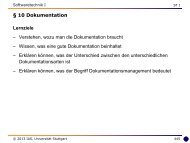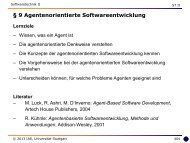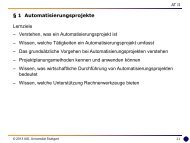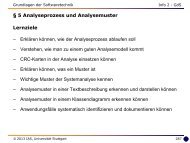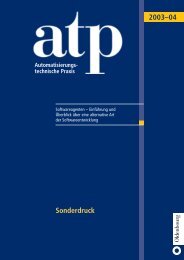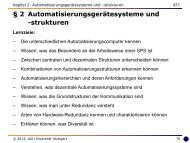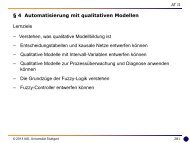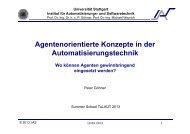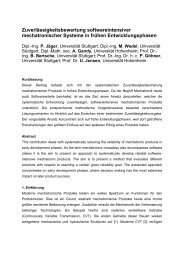Grundlagen FlexRay - Institut für Automatisierungs- und ...
Grundlagen FlexRay - Institut für Automatisierungs- und ...
Grundlagen FlexRay - Institut für Automatisierungs- und ...
Create successful ePaper yourself
Turn your PDF publications into a flip-book with our unique Google optimized e-Paper software.
<strong>Gr<strong>und</strong>lagen</strong> <strong>FlexRay</strong> BasicsV 1.1 22<br />
2.6 Wakeup<br />
The transition from the low power state to a powered state of the Bus Drivers is called<br />
Wakeup. This transition can be initialized by the Communication Controller, or by the bus<br />
itself, if the Bus Driver receives Wakeup Patterns. For the latter, the Bus Driver has to<br />
identify at least two Wakeup Symbols.<br />
Not every ECU on a network is allowed to send Wakeup Patterns. If a ECU has the<br />
permission to send such patterns, it is called a Wakeup Node, and may send 2 to 63 Wakeup<br />
Symbols.<br />
A Wakeup Symbol is defined (see Figure 2.17) as a Data_0 phase followed by an Idle phase.<br />
To ensure the Bus Driver can identify these phases, the following timing constraints have to<br />
be obeyed: dWU 01 , dWU Idle1 , dWU 02 , dWU Idle2 > 4µs <strong>und</strong> dWU < 48µs.<br />
Figure 2.17 Wakeup Pattern [EPLS06]<br />
A network may only contain up to 3 Wakeup Nodes, since an overlap of several Wakeup<br />
Patterns could prevent a correct detection, see Table 2.2.<br />
Table 2.2 Wakeup Pattern Detection [EPLS06]<br />
Name Description Min Max Unit<br />
dWU 0Detect Acceptable limits for detecting a 1 4 µs<br />
Data_0 phase.<br />
dWU IdleDetect Acceptable limits for detecting an 1 4 µs<br />
Idle phase.<br />
dWU Timeout Acceptable limits for detecting a<br />
Wakeup Pattern<br />
48 140 µs<br />
However, it is possible to define different Wakeup Nodes for channels A and B. This opens<br />
up additional possibilities for the network designer, as seen in the example in Figure 2.18.<br />
Here, the network on channel A is woken up by ECU1 due to a local event, while channel B is<br />
still asleep.<br />
Bäurle 12.10.2012




